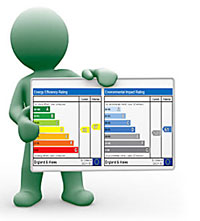Home Information Packs - What is an Energy Performance Certificate (EPC)

The facts about EPC's
- Energy Performance Certificates (EPC's) give home buyers and sellers an A to G ratings for their home’s energy efficiency to help cut carbon emissions and fuel bills.
- Our homes already account for 27% of the UK’s carbon emissions contributing to global climate change.
- The EPC is designed to help homeowners reduce the environmental impact of their homes.
- The Energy Savings Trust estimates that by following the recommendations in an EPC, an average of £300 a year can be saved in fuel bills.
- The EPC should be shown, on request, to any prospective purchaser, and should in any case be provided by the owner to the ultimate purchaser before a contract for sale is made.
- Sellers of newly built homes will have to provide a predicted assessment of the energy efficiency of the property, but a full EPC should be provided to the buyer when the home is completed.
- By 2009, all buildings in the UK that are constructed, sold or rented out will have to have an EPC, in accordance with the European Energy Performance of Buildings Directive. It is estimated that 1.5 million EPC’s will be required each year.
Why is the Certificate important?
Nearly 40 per cent of the UK's energy consumption arises from the way in which our 25 million buildings are lit, heated and used. Even comparatively minor changes in energy performance and the way we use each building will have a significant effect in reducing energy consumption - and therefore carbon emissions.
How is my home's rating calculated?
A non-invasive inspection of your property, undertaken by a qualified and accredited Domestic Energy Assessor (DEA) will give your home a rating on a scale of A-G.
Because the inspection is non-invasive, then there will be no disturbance to the fabric of your home, for example no drilling or removal of fixed panels will take place.
Your EPC will detail recommendations of how you can improve the efficiency of your home - some of which may have little cost to implement.
Typically the survey undertaken by the DEA shall include:-
- Assess property age and construction type photograph front and rear elevations.
- Measure property dimensions and draw a sketch plan of all the floors.
- Photograph and detail heating system and controls.
- Check if double glazed and if so ask for FENSA cert if available (need proof if post 2002).
- Check loft space for insulation and construction type if applicable.
- If extension / loft conversion present note dimensions, type and age.
- Complete onsite Data (RdSAP) collection forms.
What does my certificate contain?
The form and content of the certificate is prescribed by the regulations and includes the following:
- Tables showing your home's current and potential energy efficiency and environmental impact ratings. These look similar to those already found on white goods such as fridges and washing machines telling you how energy a product is with a rating awarded between "A" and "G".
- Approximate energy use and fuel costs to provide heat, light and hot water to the property in its current state and the associated carbon dioxide emissions in doing so.
- Details of lower and higher cost measures that can be used on the property to improve its energy efficiency and environmental impact.
- Expected cost savings and predicted performance ratings if the improvement measures were to be carried out as recommended by the assessor.
What happens to Energy Performance Certificates once they're completed?
All domestic Energy Performance Certificates are logged in a central database. Energy Assessors (through their Accreditation Schemes) log them as they produce them, and each is given a unique reference number. Access to the database is restricted, so only those who have the unique reference number can access the certificate for a particular property.
What does an EPC look like?
Click below to view a dummy Energy Performance Certificate taken from a real Home Information Pack.
Example Domestic Energy Certificate
